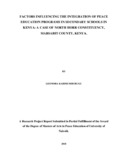| dc.description.abstract | The purpose of the study was to examine factors influencing the integration of peace education programs in secondary schools using the case of North Horr Constituency, Marsabit County, Kenya. The study was guided five objectives; to establish how the existing peace education strategies influence the integration of peace education in sec schools, to determine how availability of trained teachers influence integration of Peace education programs in Secondary Schools, to establish how availability of learning resources influence integration of peace education programs in Kenya, to identify how peace education integration challenges faced by teachers influence integration of peace education programs and to identify peace education integration challenges facing education administrators of secondary schools in North Horr constituency and their influence on extent of integration of peace education programs. Descriptive research design was applied for the study. Simple random sampling was used to get a sample size of 133 students, 113 teachers and 4education stakeholders (representing the Government – ministry of education, Local community leadership, NGOs, CBOs). Semi structured questionnaires were administered to the participants mostly to collect quantitative data, while a focus group discussion involving the education administrators was conducted to provide qualitative data to complement the quantitative data. The findings highlight that schools have, to a considerable degree, embraced the integrative approach; elements of peace education programs have been incorporated into the classrooms through subjects such as life skills, meetings and forums for awareness creation, alongside the mainstream subjects that touch on peace such as Social Studies, Religious Education and History and Government, as represented in the analysis results. In regards to the availability and adequacy of resources for the integration of peace education, as indicated in table, majority (mode=4) of respondents ‘disagreed’ that the needful materials and equipment to integrate peace education programmes (text books, story books, peace manuals, charts, peace films, peace documentaries are available. A closely relatable response pattern was observed in regards to the integration of PE through the formal curriculum. Notably, factors under consideration in this study, education strategies, availability of trained teachers, availability of learning resources and challenges facing education administrators and teachers have significant influence on the integration of peace education in Secondary schools. While the integration challenges cited are sizeable and far from adequately addressed, considerable progress has been made in these schools in regards to peace education integration; Peace committees have been constituted to lead peace initiatives, peaceful co-existence of students from the various ethnic tribes is being realized through the promotion of extra curriculum activities such as sports, drama and music festivals as channels of peace integration. | en_US |



